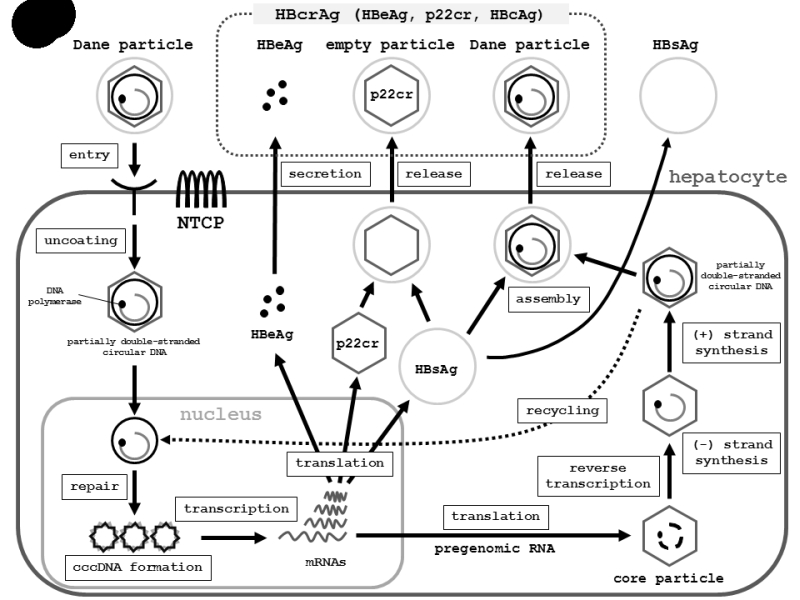FIGURE 2: Schematic representation of the HBV lifecycle, from entry into hepatocytes to release from hepatocytes. Entry: HBV (Dane particle) obtains entry into hepatocytes by binding to the receptor NTCP [37, 38, 39] and possible additional hepatocyte-specific factors on the cell surface. The HBV membrane fuses with the membrane of the host hepatocyte, and the virion is endocytosed. Uncoating: The HBV membrane releases the viral DNA (partially double-stranded circular DNA) with the core particle into the cytoplasm [39]. The viral membrane is lost (uncoating). The viral nucleocapsid containing the viral genomic DNA is transported into the nucleus in the relaxed circular form. Repair and cccDNA formation: In the nucleus, the viral DNA polymerase synthesizes fully double-stranded DNA, and fully double-stranded DNA is converted to a cccDNA by the viral DNA polymerase [38, 39]. The formation of cccDNA remains poorly understood. It is most likely formed via the DNA repair mechanism [38]. Transcription: cccDNA is transcribed into the pregenomic and subgenomic mRNAs by host RNA polymerase [38, 39]. Translation and reverse transcription: Pregenomic RNA is the template for the translation of both DNA polymerase and the core proteins, and for reverse transcription. The DNA polymerase binds to the packaging signal of the pregenomic RNA, and both are then combined into the viral capsid, which is the core particle [38, 39]. The HBV genome matures in the core particle via reverse transcription of pregenomic mRNA to DNA [39]. DNA synthesis: After synthesis of the (-) strand DNA and (+) strand DNA, the nucleocapsid, containing partially-double stranded circular DNA, is generated. Assembly: HBsAg and the nucleocapsid containing partially double-stranded circular DNA are assembled together to become a new complete virion [39]. Release: The mature HBV virion (Dane particle) is released from the infected hepatocyte or is recycled back into the nucleus for amplification of cccDNA [38]. Other events: The C gene directs the synthesis of two major gene products: HBcAg (p21c), which comprises the nucleocapsid; and HBeAg (p17e), which is a secreted antigen. Noninfectious particles (empty particles), which are composed of HBsAg, a 22-kDa precore protein (p22cr), and HBeAg, are also produced as a trap for the host immune system, in order to protect the infectious Dane particles. Serologic testing can assess HBeAg, p22cr, and HBcAg as hepatitis B core-related antigen (HBcrAg). Abbreviations: HBV, hepatitis B virus; NTCP, sodium taurocholate cotransporting polypeptide; cccDNA, covalently closed circular DNA; RC-DNA, relaxed circular DNA; HBsAg, hepatitis B virus surface antigen; HBcAg, HBV core antigen; HBV e antigen, HBeAg; p22cr, precore protein; HBcrAg, hepatitis B core-related antigen.
37. Gerlich WH (2013). Medical virology of hepatitis B: how it began and where we are now. Virol J 10: 239. http://dx.doi.org/10.1186/1743-422x-10-239
38. Hawkins C, Christian B, Ye J, Nagu T, Aris E, Chalamilla G, Spiegelman D, Mugusi F, Mehta S, Fawzi W (2013). Prevalence of hepatitis B co-infection and response to antiretroviral therapy among HIV-infected patients in Tanzania. Aids 27(6): 919-927. http://dx.doi.org/10.1097/qad.0b013e32835cb9c8
39. Wandeler G, Gsponer T, Bihl F, Bernasconi E, Cavassini M, Kovari H, Schmid P, Battegay M, Calmy A, Egger M, Furrer H, Rauch A (2013). Hepatitis B virus infection is associated with impaired immunological recovery during antiretroviral therapy in the Swiss HIV cohort stud. J Infect Dis 208(9): 1454-1458. http://dx.doi.org/10.1093/infdis/jit351

